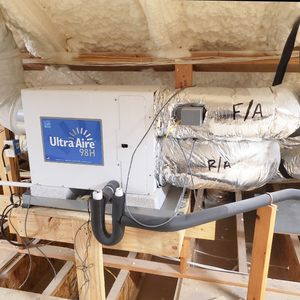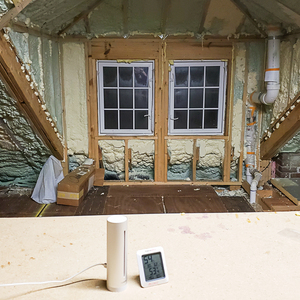
Moses Draper and his family are spending their first summer in their new house in southern Vermont. The 1,200-square-foot house is well insulated and very tight, so the summer should be a pleasant experience for the Drapers. Except that it’s not turning out that way.
“Most of the summer, we’ve been experiencing high humidity inside the house,” Draper writes in a Q&A post. “Our small, inexpensive thermostat/moisture meter, is usually at 99%. We have started to notice a couple isolated items with mold on them and I’m wondering what to do about it.”
The house, constructed on a concrete slab, has double-stud walls 12 inches thick that are insulated with cellulose. The vented roof has 18 inches of insulation, and a blower door test measured airtightness at 0.39 ach50. Draper has installed two Lunos vents in the walls, which operate on high except when windows are open at night. Draper says that he is “religious” about running his range hood and bathroom exhaust fans. In other words, much about the house seems right.
Yet mold is showing up in what Draper describes as “isolated pockets” — shoes in the entrance closet, wooden toys, on a refrigerator magnet. It’s possible the family imported some mold from its previous dwelling (a yurt).
“Do we need to increase our whole house ventilation, or is this just endemic to summers in a humid climate?” Draper asks. “Is something like a dehumidifier the best response?”
That’s the question for this Q&A Spotlight.
Get a new hygrometer
It’s very unlikely that either the indoor relative humidity or the moisture content of any wood in the house is actually 99%, says GBA editor Martin Holladay.
During the summer, indoor relative humidity in a house without air conditioning could easily be 60%. If…
Weekly Newsletter
Get building science and energy efficiency advice, plus special offers, in your inbox.

This article is only available to GBA Prime Members
Sign up for a free trial and get instant access to this article as well as GBA’s complete library of premium articles and construction details.
Start Free TrialAlready a member? Log in















10 Comments
I have a somewhat related issue.
I own a century old home that is leaky and a partial uncovered dirt crawlspace (and poor insulation). Fixing all these is problematic but my humidity this past summer (near Toronto Ontario) has gravitated between 60-100% (with a cheap humidity meter). No mold fortunately but its something i am concerned about and my AC use is sparing. I can't get the humidity below 60% no matter what, i could run the AC (which is old and inefficient) 24/7 and the humidity will stay at 60-70%. I don't do this so have had to live with higher humidity.
If the OP is noticing mold then they really need to get it under control of course. The dehumidifier penalty is not huge, according to another article it would use 1000btu/pint plus the energy usage of the device. At 1 gallon a day removal thats about an extra 8000btu plus electricity, i could not find the current energy star guideline on a quick search but if we assume 2L/kWh with some overhead thats another 7000btu. So 15,000btu of extra heat per gallon, not sure how much that adds to the OP's internal heat load.
This would probably diminish after a few days, but it may also be worth considering a cheap window shaker.
Alan,
In your case, you shouldn't focus on your HVAC equipment. Instead, you need to address the dirt-floored crawlspace (by installing polyethylene over the dirt floor) and you need to perform air sealing work on your home's thermal envelope (ideally, by hiring a contractor with a blower door so that you can perform blower-door-directed air sealing).
For more on dehumidifier energy use, see "All About Dehumidifiers."
I don't disagree but i had a Q&A on this and its not quite feasible.
I do wonder if the OP's house is generating more humidity or its transient. Before i knew what i know now about this house i was wishing i could borrow a dehumidifier to see if i needed one long term or mine was transient (it was not in my case) and at what level (my basement produces about 10 pints a day do the smallest 30 pint unit is what i have and it can keep 60% while the upstairs can't get below 60%.
"It’s not surprising how dominant the latent load is for New Orleans and Miami; but Boston and Minneapolis?"
The Boston & Minneapolis cases shouldn't be surprising at all.
In those cases the latent load dominates due to the comparative lack of sensible load one gets in warmer locations. Most basements (in any climate) are cooler have almost no sensible (or even negative) sensible cooling loads- it's all latent load. An air mass moving from the Gulf of Mexico to New Engand or the upper midwest loses only some of it's moisture along the way, but a more significant amount of it's temperature, and the solar intensity at the higher latitudes is also quite a bit lower.
Two questions:
1) is there a more recent chart on latent/sensible heat loading? I'd be curious to know just how different 2017 data is from 1997.
2) In a tight home, just how much of a factor would the inhabitants play on the latent/sensible heat load? I assume there is data on inhabitant loading, but it doesn't seem to come up in conversation too much. Is it not that significant?
(I've always wondered about what happens in a tight home when I double or triple the occupancy for a weekend. That, combined with "borderline" weather, and I'd probably run out and buy the closest AC unit I could find.)
Thanks!
The paper from which that graph was copied lives here (among other places on the web) and is worth reading:
http://www.gastechnology.org/reports_software/Documents/BinMaker-Pro-Vent-Cool-Loads.pdf
I don't know of any updated versions of that graph in exactly that form using the same annual ton-hours units, but climate changes pretty slowly over time. I doubt the graph was for just the year preceding publication in 1997- it was probably at least a decade average, more likely a 25 year average. Over merely 21 years the year to year differences are likely to be bigger in magnitude than any long term trends.
Of course occupant behavior makes a significant difference in the latent cooling load on the house. People in the habit of simmering a pot of beans for hours without use of exhaust fans are contributing a large latent load, as are people who take half-hour showers without a bath fan.
Dana,
The paper gives a very detailed description of the data set. I doubt I can do it justice in summarizing it, but it is based on "typical" monthly data selected from a 30 year dataset, and it uses hour by hour data for that "typical month. There's a lot of massaging going on, but it seems like a lot of smart people worked pretty hard to make it seem like a "typical" year's worth of hour by hour data.
The author (Lew Harriman) was right on the money in proposing that sensible and latent loads be considered separately, and that systems be designed with this in mind. That's exactly what we're talking about on this thread. Lew has been one of the leading people in dehumidification technology for a couple of decades now on the commercial side. Residential equipment manufacturers are just stating to catch up, especially with low-load houses.
If your readings are confirmed to be high (70% or better) and this is truly the first summer in the home, don't forget the floor.. Looks like you have 12-18" of above grade concrete. Throw in the footers to below frost line and I assume you probably poured a lot of concrete. Likely the stuff is still drying out and is probably contributing to some of your moisture (entrance closet was the first hint. Bare concrete in the closet?). Throw in super tight construction and relatively high occupant density and high humidity is possible. And when did construction finish: were all materials dry during construction? Your conditions could be like a basement floor: any items that cover the floor are choke points for vapor diffusion; bottom of a cardboard box on the floor will slowly rot. rooms with poor circulation will have higher readings (closets) than the open spaces. Joe L./BSC have done lots of reports on this; one may be applicable to your construction.
I had seen some dessicant dehumidifiers a while ago, and just ran across some recently. I wonder if they would be a good solution to the heat dehumidifiers put out? Anyone have any experience with them to share?
I've seen them before but their capacity is low and regenerating them often involves baking them in an oven or buying disposable ones.
Log in or become a member to post a comment.
Sign up Log in